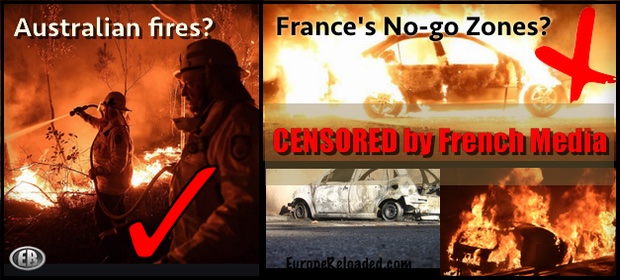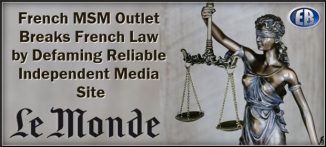
ER Editor: Just in case the sight of burning cars is too, well, boring, we offer here a brief video, contained in the reporting below, of Kalashnikov rifles being fired in a part of the southern French city of Montpellier on New Year’s Eve:
********
Cars in flames all over France at the start of the New Year
The car-burnings in France continue. There were burnt cars in Strasbourg, Bordeaux, Limoges, Nantes and other cities.
FREEWEST MEDIA
According to Dominique Jamet, the editor of conservative site Boulevard Voltaire, the French mainstream newspaper Le Monde has seen “nothing”.
Globalization is a wonderful phenomenon, especially for Le Monde keeping the French public informed on a daily basis about the fires burning in Australia and the good performance of the French car market.
“Fire? Automobile? Well no, the association of the two has not stirred the editor. Nor did the smell of burnt cars coming up from Strasbourg, the suburbs of Paris and elsewhere, many regional metropolises and sometimes even small outlying towns; no, Le Monde no longer has a sense of smell, sight or a special correspondent,” says Jamet.
At the time of writing, on 2 January, almost forty-eight hours after the fact, no summary article has been published. On the other hand, pension strike union leader Philippe Martinez, disgraced Renault boss Carlos Ghosn, and President Emmanuel Macron are being followed closely.
But the globalization of the world and the world according to Macron cannot prevent the reality of these burning cars from coming up on social networks, via a tweet from Trump or via the videos of the perpetrators bragging about it. And the regional press cannot ignore the facts, since they risk losing even more credibility.
There were cars torched in Strasbourg, according to José Meidinger. And the west and the southwest of France were not spared.
In Nantes, in the Malakoff district, at least fifteen cars were set on fire, but other areas of the city were affected, according to Ouest-France, as a police source told the daily: “We had them almost everywhere.”
In Limoges, between 26 and 36 cars were set on fire, according to Le Populaire du Centre. When questioned, the prefect’s chief of staff said that “the emergency services and the police were in a difficult spot, in particular by being targeted with projectiles launched by small groups”.
In Bordeaux, too, Sud-Ouest could not hide the reality: “Tensions in Bordeaux on New Year’s Eve: cars and garbage cans burned.” The Aubiers district was particularly affected, but in fact several municipalities in the metropolitan region were affected. The regional daily knows no more than the prefecture’s statement: “The police had to deal with tensions that began early Tuesday evening with groups of young people and resulted in car and rubbish-bin fires in several areas in the metropolis. There have been arrests following the throwing of projectiles at the police.”
Le Monde has remained silent. All that’s left are the desperate tweets from the unfortunate owners of the burned cars.
There are lawless areas in France; it’s well-known. There are also white zones, where communications are blocked, where the press does not seem to investigate. They prefer to stick to the communiqués of the prefectures.
“This is what war communication looks like, by the way,” says Jamet. There are also white periods, from 12 to 31, as well as for New Year he pointed out.
In Angoulême, the Charente Libre reported that the city also had its “urban violence” and “burnt cars” at the start of the New decade.
In 2017 — January 4 — Le Monde downplayed the phenomenon with a Shakespearean title: “Cars burned on New Year’s Eve: much ado about nothing”. A sociologist backed up their title: “This number [of burned cars] is surely a symptom of something, but we don’t know what. In any case, it doesn’t explain or tell us anything.”
A list of the “carbecues” on New Year’s Eve in France:
Montpellier: Two victims of stabbings on New Year’s Eve
Cannes: Teenagers throw mortars and smoke on the façade of the police station
Vaucluse: Always overflows (ER: French word difficult to translate) and burnt cars
Saint Etienne: Cars burnt, a family including 3 children evacuated
Besançon: 127 cars burned, brought under control after long hours of firefighting
Limoges: At least 36 cars burned, firemen attacked
Montpellier: heavy fire by Kalashnikovs
Montpellier: A young woman found dead, shot in the head
Strasbourg: At least 220 cars burned, firemen violently attacked and a cultural worker beaten
Strasbourg: Cars set on fire by “Individuals sometimes aged 10 and 12 years”.
Nantes: 7 cars burnt down last night in the Malakoff district.
Bordeaux: One vehicle burned and one damaged.
Grenoble: https://twitter.com/MatthieuGariel/status/1211965806113939456
Ailleurs: A supermarket and trees went up in flames
Vénissieux: A dozen cars burned in the night from Monday to Tuesday
Limoges: At least 36 vehicles were set on fire in several parts of the city.
Valence and Montélimar: Several vehicles set on fire, a security perimeter following a gas leak
Roubaix: A pedestrian dies after being hit by a car
Toulouse: New Year’s Eve agitated, cars and garbage cans burned.
French Riviera: Several burnt cars and an apartment set on fire
Source: F. De Souche.
************
Original article

••••
The Liberty Beacon Project is now expanding at a near exponential rate, and for this we are grateful and excited! But we must also be practical. For 7 years we have not asked for any donations, and have built this project with our own funds as we grew. We are now experiencing ever increasing growing pains due to the large number of websites and projects we represent. So we have just installed donation buttons on our websites and ask that you consider this when you visit them. Nothing is too small. We thank you for all your support and your considerations … (TLB)
••••
Comment Policy: As a privately owned web site, we reserve the right to remove comments that contain spam, advertising, vulgarity, threats of violence, racism, or personal/abusive attacks on other users. This also applies to trolling, the use of more than one alias, or just intentional mischief. Enforcement of this policy is at the discretion of this websites administrators. Repeat offenders may be blocked or permanently banned without prior warning.
••••
Disclaimer: TLB websites contain copyrighted material the use of which has not always been specifically authorized by the copyright owner. We are making such material available to our readers under the provisions of “fair use” in an effort to advance a better understanding of political, health, economic and social issues. The material on this site is distributed without profit to those who have expressed a prior interest in receiving it for research and educational purposes. If you wish to use copyrighted material for purposes other than “fair use” you must request permission from the copyright owner.
••••
Disclaimer: The information and opinions shared are for informational purposes only including, but not limited to, text, graphics, images and other material are not intended as medical advice or instruction. Nothing mentioned is intended to be a substitute for professional medical advice, diagnosis or treatment.




